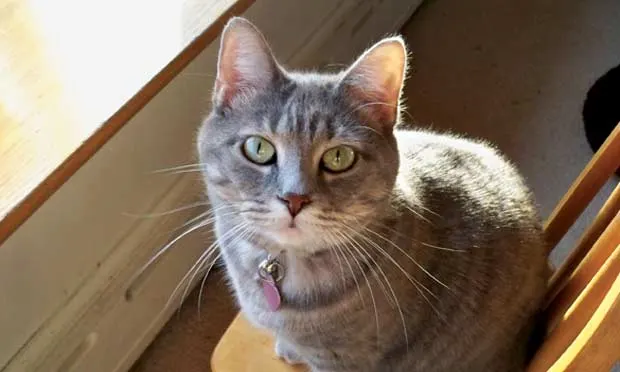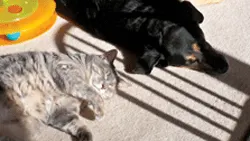Managing Exposure to Permethrin

Avery, a 2-year-old spayed domestic short-haired cat, presented with acute onset of tremors.
HISTORY
A permethrin-containing flea and tick topical spot-on product intended for dogs had been applied between the cat’s shoulder blades. Avery began “shaking” and became ataxic 30 minutes after application. The owner bathed Avery with liquid dish soap, but 90 minutes later the signs persisted without any indication of being resolved, so the owner brought Avery to the clinic.
EXAMINATION
On examination, ear and facial fasciculations were present. Avery was laterally recumbent, hypersalivating, and hyperesthetic and had marked generalized muscle tremors. During the examination, she had a grand mal seizure that lasted 5 seconds. Her rectal temperature was 103.3°F (normal, 100.5°F–102.5°F).
ASK YOURSELF...
What is the most appropriate treatment plan for Avery?
A. Bathe the cat immediately, then administer IM atropine and oral activated charcoal.B. Bathe the cat immediately, then administer IV diazepam.C. Administer IV methocarbamol, then bathe the cat.D. Administer IM atropine and oral activated charcoal, then bathe the cat.
CORRECT ANSWERC. Administer IV methocarbamol, then bathe the cat.
Because handling and bathing can exacerbate tremors or seizures, it is critical to control clinical signs first.
LABORATORY DIAGNOSTICS
The CBC and serum biochemistry profile findings, including electrolyte levels, were within reference intervals.
Because handling and bathing can exacerbate tremors or seizures, it is critical to control clinical signs first. The use of IV methocarbamol—a centrally acting muscle relaxant—is generally considered more effective than diazepam for controlling muscle tremors secondary to pyrethroid, in this case permethrin, toxicosis. If injectable methocarbamol is not available, IV diazepam can be considered as a rapid-acting anticonvulsant.
Unless there is considerable oral exposure secondary to grooming, oral decontamination is typically unnecessary. Hypersalivation seen in cats after permethrin exposure is not related to muscarinic receptor stimulation.
Both IM atropine and oral activated charcoal were contraindicated in this case because of Avery’s severe neurologic signs. Atropine is indicated for bradycardia and dyspnea secondary to bronchial secretions, which are often present in organophosphate exposures (not permethrin). In addition, cats with permethrin toxicosis may be tachycardic on presentation, and administration of atropine will exacerbate tachycardia. Atropine can also lead to hyperthermia, tremors, agitation, and seizures.
MECHANISM OF ACTION
Many topical spot-on products for dogs contain high concentrations (44%–65%) of permethrin, a synthetic pyrethroid. Derived from Chrysanthemum spp, natural pyrethrins are less potent and less stable than synthetic products.
Topical canine spot-on products usually contain concentrated permethrin, phenothrin, or cypermethrin. Some permethrin-containing products are approved for cats but contain smaller concentrations (usually <1% permethrin).1
Pyrethroids are classified into two groups: type I and type II. Permethrin, a type I pyrethroid, lacks an a-cyano group, is considered less toxic than type II, and causes repetitive action potential as a result of an increase in depolarization, resulting in discharges from sensory neurons.
Unless there is considerable oral exposure secondary to grooming, oral decontamination is typically unnecessary.
Type II pyrethroids (eg, deltamethrin, cyhalothrin, fenvalerate, cypermethrin) contain an a-cyano group, are usually found in perimeter sprays at low concentrations, and cause continued depolarization of the resting membrane, resulting in conduction block.2
As compared with insects, mammals are less affected because of a faster metabolic clearance, higher body temperature, and lower affinity of pyrethroids for sodium channels.3 Cats are more sensitive, probably because metabolism of pyrethroids involves glucuronidation. Cats have limited ability to metabolize glucuronidate compounds. Pyrethroids are also metabolized by ester hydrolysis, and cats have a slower hydrolysis rate compared with that of other species.4
Fast Fact: Pyrethroids work by slowing the opening and closing of neural sodium channels. Insects die from delayed repolarization and paralysis as a result of nervous system hyperexcitation.
CLINICAL SIGNS
With dermal exposure, pyrethroids can act directly on sensory nerve endings, causing repetitive firing.3,5 The most common adverse event with pyrethroid use in dogs is paresthesia. Clinical manifestations include pruritus, biting at the application site, and writhing of the skin over the back. Behavioral changes, such as vocalization, hesitancy to move, agitation, nervousness, and inability to walk (typically secondary to paresthesia) are also seen. In dogs, pyrethroids typically do not result in systemic or neurologic signs, as they have a greater ability than cats to metabolize these products.
In cats, systemic absorption from dermal exposure to pyrethroids can cause clinical signs of ataxia, fasciculations, generalized muscle tremors, facial and ear twitching, hyperesthesia, hypersalivation, seizures, and hyperthermia secondary to muscle activity. Clinical signs may develop within a few hours of application or may be delayed 12 to 24 hours after exposure.

TREATMENT OPTIONS
Because permethrin products are oily, a follicular flushing shampoo or liquid dish soap should be used to decontaminate the skin. Patients with severe, life-threatening signs (eg, tremors, seizures) should first be stabilized with IV methocarbamol or an anticonvulsant. Once the patient has been stabilized, it can be bathed as described.
IV versus Oral/Rectal Methocarbamol
Although IV methocarbamol is preferred, methocarbamol can be administered at 50 to 100 mg/kg PO or crushed and administered with water or saline at 100 to 150 mg/kg rectally. This can be repeated to effect q4–8h and the dose titrated to effect.Oral and rectal administration have delayed onset of action, so neither should be considered the first line of therapy. Other alternatives include phenobarbital, propofol, diazepam, or gas anesthesia.
Additional therapy includes symptomatic supportive care. IV fluids can be beneficial for patients with hyperthermia secondary to tremors. Fluids are also beneficial to diurese myoglobin from the renal tubules to prevent secondary acute renal failure. Thermoregulation is also critical, as temperatures may fluctuate in patients with tremors, after bathing, or with sedation secondary to muscle relaxants.5
Pyrethroids are lipophilic, and some anecdotal reports suggest that concentrated intralipid IV emulsion can minimize the severity and duration of clinical signs from permethrin toxicosis. However, no data support the safety or efficacy of this treatment approach in cats. In addition, such risks as hemolysis, fat emboli, and elevated liver values are associated with intralipid emulsion use. In the author’s opinion, this treatment option should be considered only when other treatments previously described have been unsuccessful.
With prompt treatment, clinical signs often resolve within 24 to 72 hours and prognosis is usually good. Rhabdomyolysis, secondary renal injury, disseminated intravascular coagulation, and cerebral ischemia could be sequelae.
OUTCOME
Avery was treated with IV methocarbamol, diazepam, phenobarbital, and fluids. Four hours after treatment was initiated, Avery became hypothermic (96°F) and heat support was initiated. Clinical signs resolved within 26 hours.
TAKE-HOME MESSAGES
Pyrethroids are not organophosphates and should not be treated with atropine. Oral activated charcoal is contraindicated in symptomatic patients and should only be used when large oral exposures have occurred.
Prognosis is generally good with prompt treatment.
Even close contact between treated dogs and cats can result in toxicity. Educate owners to avoid such risks.
AT A GLANCE
If patients are asymptomatic, prompt dermal decontamination by bathing with liquid dish soap is warranted. Symptomatic patients should be stabilized before bathing.
Treat tremors with methocarbamol(55–220 mg/kg IV, not to exceed 330 mg/kg/day). Seizures should be treated with phenobarbital (2–5 mg/kg slow IV to effect)6 or gas anesthesia.
The use of diazepam (0.5–1 mg/kg IV) or propofol (3–6 mg/kg slow IV to effect or 0.1–0.6 mg/kg/min CRI) can also be considered if other therapeutics are ineffective.
If IV methocarbamol is not available, oral or rectal doses may be helpful for mild to moderate signs.
IV fluids should be administered for supportive care.
Thermoregulation support may be necessary.
BRANDY R. SOBCZAK, DVM, is a consulting veterinarian in clinical toxicology for the ASPCA Animal Poison Control Center in Urbana, Illinois. In addition to toxicology, her research interests include animal behavior and sampling methylxanthines. She previously worked in emergency medicine and for the US Department of Agriculture. She received her DVM from Iowa State University College of Veterinary Medicine in Ames.